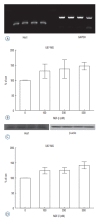Nerve Growth Factor Stimulates Glioblastoma Proliferation through Notch1 Receptor Signaling
- PMID: 29991107
- PMCID: PMC6046576
- DOI: 10.3340/jkns.2017.0219
Nerve Growth Factor Stimulates Glioblastoma Proliferation through Notch1 Receptor Signaling
Abstract
Objective: Notch receptors are heterodimeric transmembrane proteins that regulate cell fate, such as differentiation, proliferation, and apoptosis. Dysregulated Notch pathway signaling has been observed in glioblastomas, as well as in other human malignancies. Nerve growth factor (NGF) is essential for cell growth and differentiation in the nervous system. Recent reports suggest that NGF stimulates glioblastoma proliferation. However, the relationship between NGF and Notch1 in glioblastomas remains unknown. Therefore, we investigated expression of Notch1 in a glioblastoma cell line (U87-MG), and examined the relationship between NGF and Notch1 signaling.
Methods: We evaluated expression of Notch1 in human glioblastomas and normal brain tissues by immunohistochemical staining. The effect of NGF on glioblastoma cell line (U87-MG) was evaluated by 3-(4, 5-dimethylthiazol-2-yl)-2, 5-diphenyltetrazolium bromide (MTT) assay. To evaluate the relationship between NGF and Notch1 signaling, Notch1 and Hes1 expression were evaluated by reverse transcription polymerase chain reaction (RT-PCR) and Western blot analysis, respectively. To confirm the effects of NGF on Notch1 signaling, Notch1 and Hes1 small interfering RNAs (siRNAs) were used.
Results: In immunohistochemistry, Notch1 expression was higher in glioblastoma than in normal brain tissue. MTT assay showed that NGF stimulates U87-MG cells in a dose-dependent manner. RT-PCR and Western blot analysis demonstrated that Notch1 and Hes1 expression were increased by NGF in a dose-dependent manner. After transfection with Notch1 and Hes1 siRNAs, there was no significant difference between controls and 100 nM NGF-β, which means that U87-MG cell proliferation was suppressed by Notch1 and Hes1 siRNAs.
Conclusion: These results indicate that NGF stimulates glioblastoma cell proliferation via Notch1 signaling through Hes 1.
Keywords: Glioblastoma; Nerve growth factor; Notch1.
Conflict of interest statement
No potential conflict of interest relevant to this article was reported.
Figures





Similar articles
-
Propranolol Inhibits the Proliferation of Human Glioblastoma Cell Lines through Notch1 and Hes1 Signaling System.J Korean Neurosurg Soc. 2021 Sep;64(5):716-725. doi: 10.3340/jkns.2021.0068. Epub 2021 Aug 11. J Korean Neurosurg Soc. 2021. PMID: 34376038 Free PMC article.
-
The vascular delta-like ligand-4 (DLL4)-Notch4 signaling correlates with angiogenesis in primary glioblastoma: an immunohistochemical study.Tumour Biol. 2016 Mar;37(3):3797-805. doi: 10.1007/s13277-015-4202-8. Epub 2015 Oct 15. Tumour Biol. 2016. PMID: 26472724
-
Notch intracellular domain regulates glioblastoma proliferation through the Notch1 signaling pathway.Oncol Lett. 2021 Apr;21(4):303. doi: 10.3892/ol.2021.12564. Epub 2021 Feb 19. Oncol Lett. 2021. PMID: 33732379 Free PMC article.
-
Hes1, an important gene for activation of hepatic stellate cells, is regulated by Notch1 and TGF-β/BMP signaling.World J Gastroenterol. 2015 Jan 21;21(3):878-87. doi: 10.3748/wjg.v21.i3.878. World J Gastroenterol. 2015. PMID: 25624721 Free PMC article.
-
Curcumin-mediated regulation of Notch1/hairy and enhancer of split-1/survivin: molecular targeting in cholangiocarcinoma.J Surg Res. 2015 Oct;198(2):434-40. doi: 10.1016/j.jss.2015.03.029. Epub 2015 Mar 19. J Surg Res. 2015. PMID: 25890434 Review.
Cited by
-
Type 1 Insulin-Like Growth Factor Receptor Nuclear Localization in High-Grade Glioma Cells Enhances Motility, Metabolism, and In Vivo Tumorigenesis.Front Endocrinol (Lausanne). 2022 Apr 27;13:849279. doi: 10.3389/fendo.2022.849279. eCollection 2022. Front Endocrinol (Lausanne). 2022. PMID: 35574033 Free PMC article.
-
Glioma‑neuronal interactions in tumor progression: Mechanism, therapeutic strategies and perspectives (Review).Int J Oncol. 2022 Sep;61(3):104. doi: 10.3892/ijo.2022.5394. Epub 2022 Jul 20. Int J Oncol. 2022. PMID: 35856439 Free PMC article. Review.
-
Amino acid metabolism in glioblastoma pathogenesis, immune evasion, and treatment resistance.Cancer Cell Int. 2025 Mar 13;25(1):89. doi: 10.1186/s12935-025-03721-1. Cancer Cell Int. 2025. PMID: 40082966 Free PMC article. Review.
-
Gas Plasma Exposure of Glioblastoma Is Cytotoxic and Immunomodulatory in Patient-Derived GBM Tissue.Cancers (Basel). 2022 Feb 5;14(3):813. doi: 10.3390/cancers14030813. Cancers (Basel). 2022. PMID: 35159079 Free PMC article.
-
Propranolol Inhibits the Proliferation of Human Glioblastoma Cell Lines through Notch1 and Hes1 Signaling System.J Korean Neurosurg Soc. 2021 Sep;64(5):716-725. doi: 10.3340/jkns.2021.0068. Epub 2021 Aug 11. J Korean Neurosurg Soc. 2021. PMID: 34376038 Free PMC article.
References
-
- Artavanis-Tsakonas S, Rand MD, Lake RJ. Notch signaling: cell fate control and signal integration in development. Science. 1999;284:770–776. - PubMed
-
- Aster JC, Pear WS. Notch signaling in leukemia. Curr Opin Hematol. 2001;8:237–244. - PubMed
-
- Bolós V, Grego-Bessa J, de la Pompa JL. Notch signaling in development and cancer. Endocr Rev. 2007;28:339–363. - PubMed
LinkOut - more resources
Full Text Sources
Other Literature Sources

